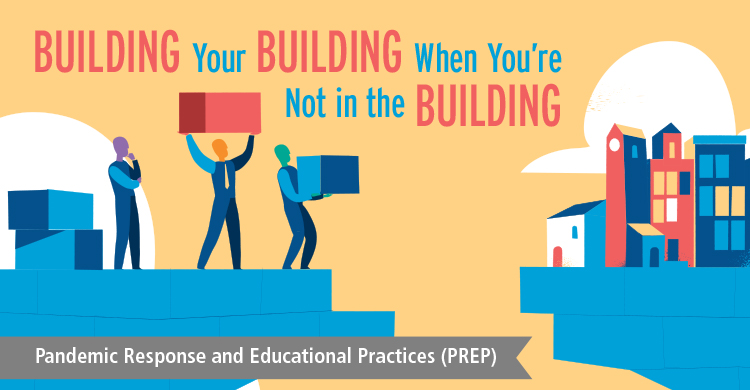This entry is the fifth in a blog series called Pandemic Response and Educational Practices (PREP), which aims to highlight and further the important work educators are doing amid the worldwide COVID-19 crisis.
Based on Building Your Building: How to Hire and Keep Great Teachers.
Surreal. Unbelievable. No words. None of us can quite put into words what we’re going through right now during this global pandemic.
As school leaders, we are trying to make sense of this, while at the same time leading our building—remotely. And this is the time of the year when we make the most important decisions: Who are we going to bring to join our team? How will we make the best decisions when it comes to hiring teachers? And now the challenge is—how do we make those most important decisions virtually?
Begin Now and Network
First and foremost, stop waiting. The hiring process should have started yesterday. Don’t wait for the pandemic to be over. Don’t wait for the buildings to open. Timing is everything with good hiring. The sooner you begin, the better your chances of getting the best candidates will be.
In addition, this is also a great time to begin networking. Send emails or call other school leaders you trust, and ask them if they know of anyone good. Chances are, they could have interviewed someone they really liked—but didn’t have the vacancy at the time for that person.
With that in mind, you should always pay it forward, too. When you come across a strong candidate that you can’t hire, let your colleagues know about him/her. We are all in this together in the pursuit of hiring the best teachers for our students, so we should always help each other out.
The Virtual Interview: Before
There should be a lot of prep work done before the actual interview process. Virtual interviews are no different. Let’s go through a few things you should do before any virtual interview takes place:
Interview Team
Who is going to be on your interview team? This step is no different than when we were in our buildings. You should never interview alone—you need a team to help provide input and also be a part of the decision-making process of who will become a member of the team.
This interview team can be different (for example, your interview team could depend on where the vacancy is), or it can be the same team for every interview. But ensure you have people on the interview team who will give you a good perspective on the candidate so you can collaboratively make the decision.
The Questions
Plan out the questions ahead of time. These questions should be based on what you are looking for. And always ask a variety of questions: situational questions (give them a scenario and ask them how they would handle it), behavior questions (ask them to describe a time they had to do something), and traditional questions (typical questions related to strengths or weaknesses or why they should be selected).
In addition to creating questions, ensure you have some way to rate the candidate’s responses. In Building Your Building: How to Hire and Keep Great Teachers, Scott Cunningham and I provide more than 100 sample interview questions, as well as some examples of rubrics to rate the answers.
The Task
It is always beneficial to have the candidate come prepared to teach a lesson or bring a video of them teaching a lesson—but of course, that could be difficult at the moment, given our circumstances. So, think of other creative ways to have the candidate engage in a task that will help reveal whether or not he or she would be a great addition to your team.
Some examples:
- Have the candidate view a lesson ahead of time (you could download lessons from the internet) and ask them to come to the interview prepared to answer questions related to the quality of that lesson (e.g., “How could they make the lesson better?”).
- Give the candidate a scenario of a problem ahead of time (e.g., a student who just isn’t learning a particular standard or a student who continues to display behavior issues in the classroom) and ask them to come prepared with a plan on how to address the problem.
- Provide the candidate with an example email from a very upset parent, and ask the candidate to come prepared to the interview with a response.
Practice the Platform
When you set the interviews up, do them using a platform where you can see the candidates—and let them know in advance what platform you will be using (Zoom, Teams, FaceTime, etc.). Practice the use of the platform ahead of time with your interview team, so everyone has a good grasp of the technology. In addition, prepare who will ask which question, as well as the order of the questions.
Virtual Interviews: During
During the virtual interview, pay attention to the candidate. It can be very easy to get distracted while doing this online, but do your best to refrain from going on your phone or looking somewhere else.
Dress professionally as well, be in a professional setting, and stick to the planned questions—remember, if it’s a great candidate, he or she will have options. As such, you want to create an environment that if selected, he or she will want to work at your school.
Virtual Interviews: After
Once the interview is over, ensure the candidate has left the platform. Then, begin a debriefing session where each member of the interview team presents his or her ratings and opinions of the candidate based on his or her answers. This discussion is vital in helping you decide which candidate will be the best fit for your school.
Reference Checks
Always, always, always do reference checks. Reference checks give you the ability to check into the validity of the candidate’s answers, and also into a glimpse of his or her work ethic.
The reference part of the selection process is one of the most important to help you decide who gets to be on your team. This should be no different than when we were in our buildings—just pick up the phone and call! Be prepared with which questions you’re going to ask to help you determine if this will be the perfect candidate for your school. In Building Your Building, we provide several sample reference questions you could use.
No Room for Mistakes
In conclusion, there is no doubt that we are going through an unprecedented time. It can be difficult to continue to do the work as if everything was normal, but when it comes to staffing your building, we absolutely have to.
We cannot make mistakes by hiring the wrong people, because we all know the consequences of those mistakes. We have to proactively ensure we are staffing our building with the best candidates, and we have to ensure we have a process in place to help us do that—even if that process has become virtual.
[author_bio id=”160″]







